
Chapter 15 - Entry Strategy and Strategic Alliances
15-1
Entry Strategy and Strategic Alliances
Learning objectives
• Explain the three basic
differences that firms
contemplating foreign
expansion must make: which
markets to enter, when to enter
those markets, and on what
scale.
• Compare and contrast the
different modes that firms use
to enter foreign markets.
• Identify the factors that
influence a firm’s choice of
entry strategy.
• Recognize the pros and cons of
acquisitions versus greenfield
ventures as an entry strategy.
• Evaluate the pros and cons of
entering into strategic alliances.
This chapter is concerned with three closely related topics:
the decisions of which markets to enter, when to enter
those markets, and on what scale.
When a firm that wishes to enter a foreign market, it has
several options, including exporting, licensing or
franchising to host country firms, setting up a joint venture
with a host country firm, or setting up a wholly owned
subsidiary in the host country to serve that market. Each
of these options has its advantages and each has its
disadvantages.
Strategic alliances have become more frequent. They may
be seen as one way for firms to enter into cooperative
agreements between actual or potential competitors. The
term "strategic alliances" is often used rather loosely to
include a wide range of arrangements between firms,
including cross-share holding deals, licensing
arrangements, formal joint ventures, and informal
cooperative deals.
The magnitude of the advantages and disadvantages
associated with each entry mode are determined by a
number of different factors, including transport costs and
trade barriers, political and economic risks, and firm
strategy.
The opening case explores how General Motors focused
on China as its next growth market. The company used a
joint venture strategy in the market and by 2010 sold more
cars in China than in the United States. The closing case
discusses General Electric’s changing perspective on the
value of joint ventures as a market entry mode. In the
past, General Electric has avoided joint ventures and the
shared control they imply when entering foreign markets,
but more recently, the company has embraced the entry
mode as a means of acquiring knowledge of the local
market.
15

Chapter 15 - Entry Strategy and Strategic Alliances
15-2
OUTLINE OF CHAPTER 15: ENTRY STRATEGY AND STRATEGIC
ALLIANCES
Opening Case: General Motors in China
Introduction
Basic Entry Decisions
Which Foreign Markets?
Timing of Entry
Scale of Entry and Strategic Commitments
Summary
Management Focus: Tesco’s International Growth Strategy
Management Focus: The Jollibee Phenomenon—A Philippine Multinational
Entry Modes
Exporting
Turnkey Projects
Licensing
Franchising
Joint Ventures
Wholly Owned Subsidiaries
Selecting an Entry Mode
Core Competencies and Entry Mode
Pressures for Cost Reductions and Entry Mode
Greenfield Venture or Acquisition?
Pros and Cons of Acquisitions
Pros and Cons of Greenfield Ventures
Greenfield or Acquisition?
Strategic Alliances
The Advantages of Strategic Alliances
The Disadvantages of Strategic Alliances
Making Alliances Work
Management Focus: Cisco and Fujitsu
Chapter Summary
Critical Thinking and Discussion Questions
Closing Case: General Electric’s Joint Ventures
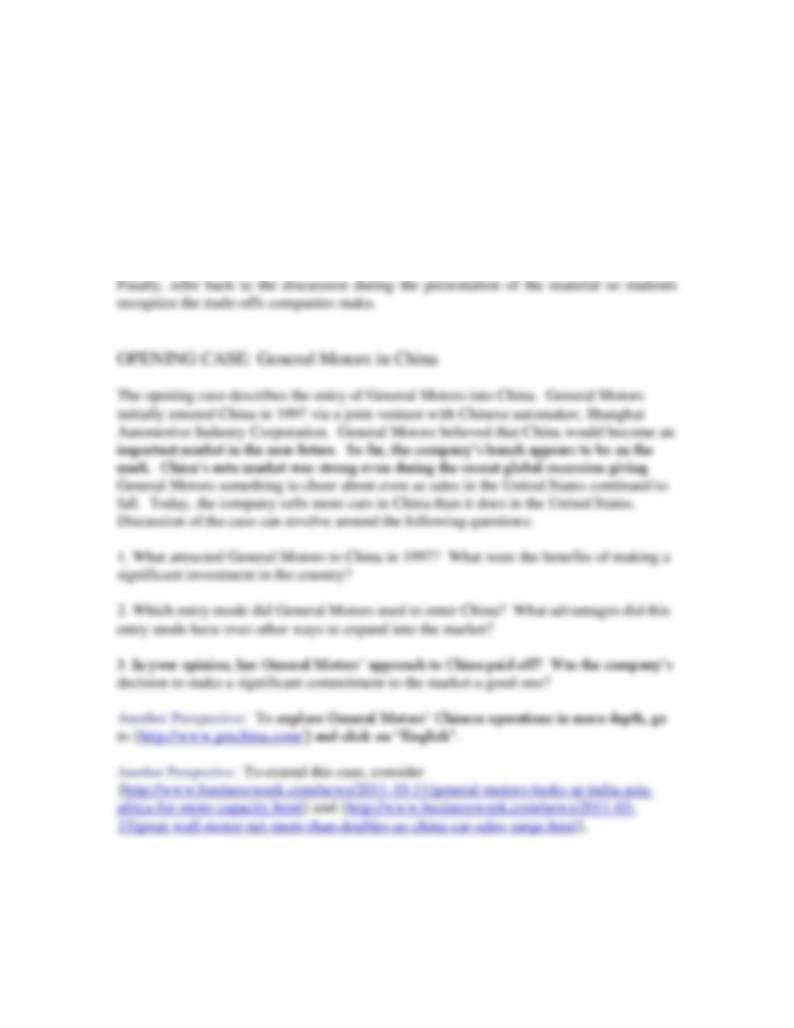
Chapter 15 - Entry Strategy and Strategic Alliances
15-3
CLASSROOM DISCUSSION POINT
Ask students to find several examples of companies expanding into new markets.
Students can use publications like the Wall Street Journal or Business Week as sources.
Then ask students to consider why the companies involved chose the form of market
entry involved.
Try to get students to think about the trade-offs involved with the various forms of
market entry. Jot their responses on the board using the framework presented in the text.

Chapter 15 - Entry Strategy and Strategic Alliances
LECTURE OUTLINE FOR CHAPTER
This lecture outline follows the Power Point Presentation (PPT) provided along with this
instructor’s manual. The PPT slides include additional notes that can be viewed by
clicking on “view”, then on “notes”. The following provides a brief overview of each
Power Point slide along with teaching tips, and additional perspectives.
Slide 15-3 Basic Entry Decisions
Firms expanding internationally must decide which markets to enter, when to enter them
and on what scale, and which entry mode to use. Entry modes include exporting,
licensing or franchising to a company in the host nation, establishing a joint venture with

Chapter 15 - Entry Strategy and Strategic Alliances
Slide 15-15 Exporting
Exporting avoid costs of investing in new location and may help achieve experience
curve and location economies. Exporting faces challenges from tariff barriers,
transportation costs, control over marketing, and local low-cost manufacturers.
Another Perspective: The Business Link {http://www.canadabusiness.ca/eng/} provides
information companies should know before they begin exporting. Students can click on
the various topics to learn more about export financing, export plans, dealing with risk,
and so on.
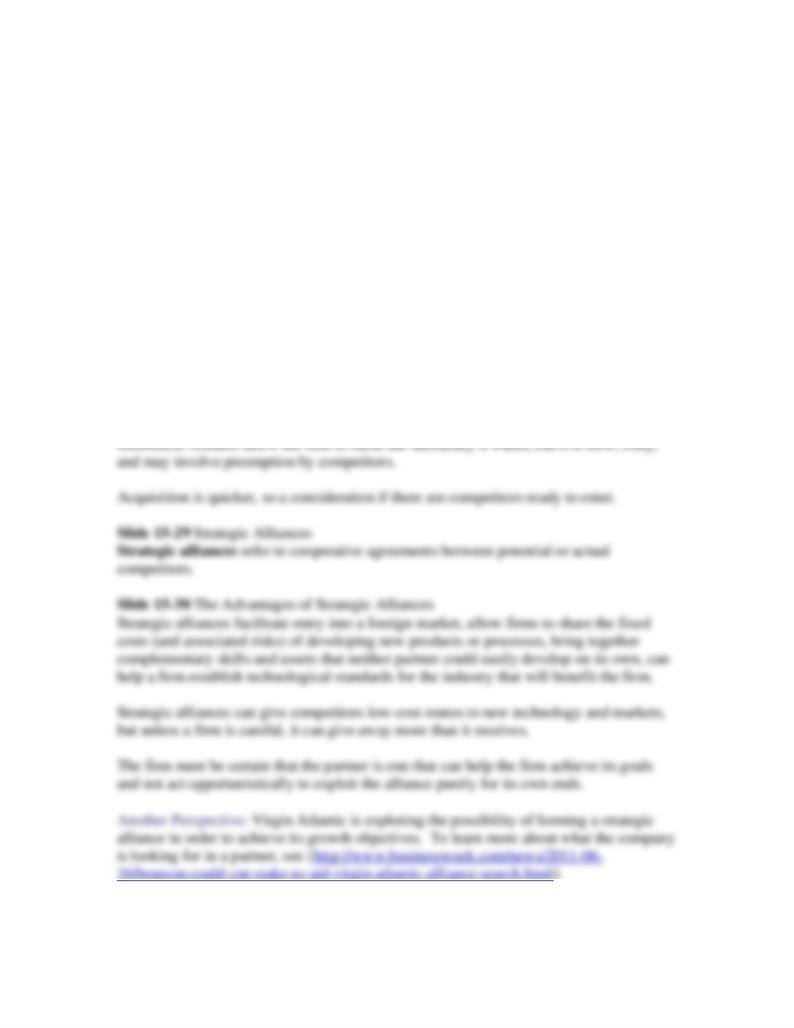
Chapter 15 - Entry Strategy and Strategic Alliances
15-6
Slide 15-23 Core Competencies and Entry Mode
The optimal choice of entry mode for firms pursuing a multinational strategy depends to
some degree on the nature of their core competencies.
Slide 15-24 Pressures for Cost Reductions and Entry Mode
When pressure for cost reductions is high, firms are more likely to pursue some
combination of exporting and wholly owned subsidiaries.
Slides 15-25-15-26 Greenfield Ventures or Acquisitions
Firms can establish a wholly owned subsidiary in a country through a greenfield
strategy (building a subsidiary from the ground up) or through an acquisition strategy.
Slide 15-27 Pros and Cons of Acquisitions
Pros: quick, preemptive, possibly less risky. Cons: disappointing results, overpay,
optimism/hubris, culture clash, failure of synergies
Slide 15-28 Pros and Cons of Greenfield Ventures
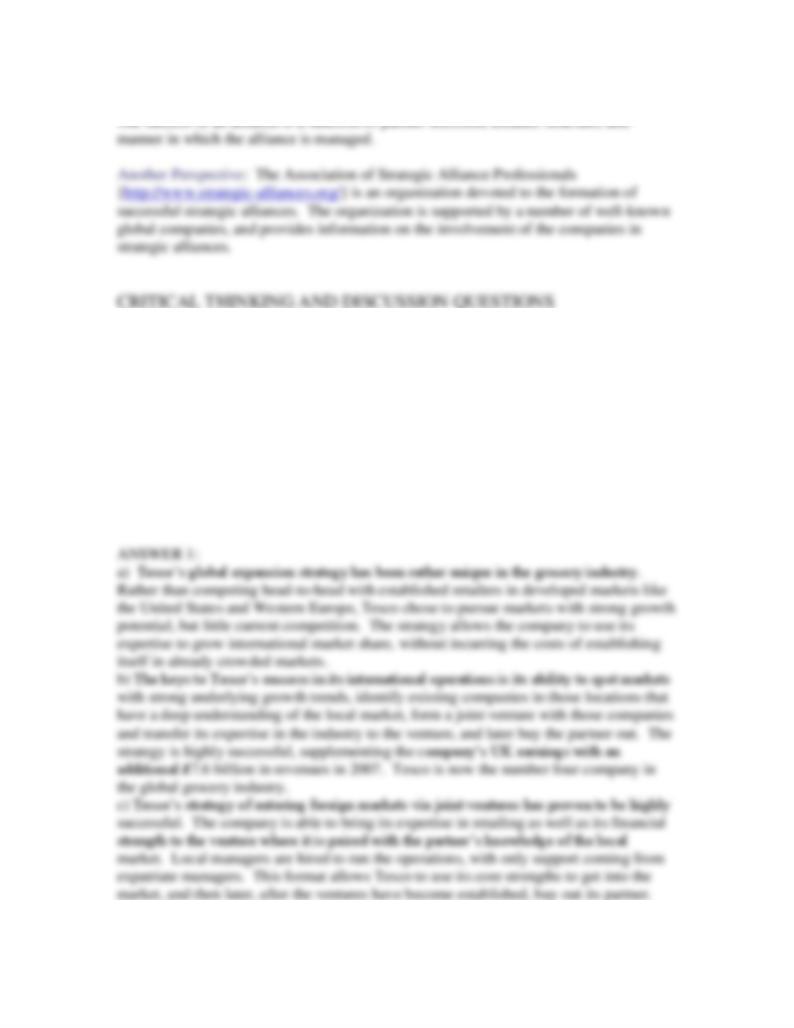
Chapter 15 - Entry Strategy and Strategic Alliances
15-7
Slides 15-31-15-33 Making Alliances Work
QUESTION 1: Reread the Management Focus on Tesco. Then answer the following
questions:
a) Why did Tesco’s initial international expansion strategy focus on developing nations?
b) How does Tesco create value in its international operations?
c) In Asia, Tesco has a long history of entering into joint venture agreements with local
partners. What are the benefits of doing this for Tesco? What are the risks? How are
those risks mitigated?
d) In March 2006, Tesco announced that it would enter the United States. This represents
a departure from its historic strategy of focusing on developing nations. Why do you
think Tesco made this decision? How is the U.S. market different from others Tesco has
entered? What are the risks here? How do you think Tesco will do?

Chapter 15 - Entry Strategy and Strategic Alliances
15-8
d) Most students will probably agree that while Tesco’s entry into the crowded market in
the United States represents a departure from its traditional strategy of focusing on
developing nations with little existing competition, the strategy still reflects the
company’s traditional strategy in that the format the company has chosen to use, Tesco
QUESTION 2: Licensing propriety technology to foreign competitors is the best way to
give up a firm's competitive advantage. Discuss.
QUESTION 3: Discuss how the need for control over foreign operations varies with
firms’ strategies and core competencies. What are the implications of the choice of entry
mode?

Chapter 15 - Entry Strategy and Strategic Alliances
QUESTION 4: A small Canadian firm that has developed some valuable new medical
products using its unique biotechnology know-how is trying to decide how best to serve
the European Union. Its choices are given below. The cost of investment in
manufacturing facilities will be a major one for the Canadian firm, but it is not outside its
reach. If these are the firm’s only options, which one would you advise it to choose?
Why?
a. Manufacture the product at home and let foreign sales agents handle marketing.
b. Manufacture the products at home and set up a wholly owned subsidiary in Europe to
handle marketing.
c. Enter into a strategic alliance with a large European pharmaceutical firm. The product
would be manufactured in Europe by the 50/50 joint venture and marketed by the
European firm.
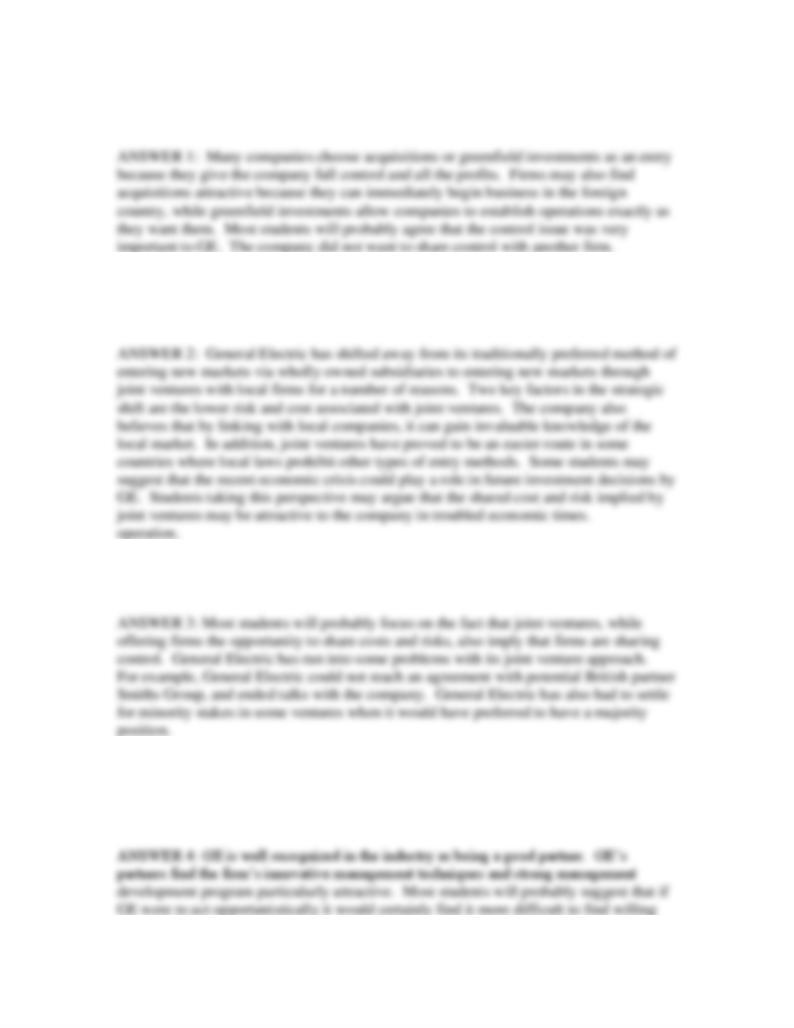
Chapter 15 - Entry Strategy and Strategic Alliances
15-10
QUESTION 1: GE used to have a preference for acquisitions or greenfield ventures as
an entry mode, rather than joint ventures. Why do you think this was the case?
QUESTION 2: Why do you think that GE has come to prefer joint ventures in recent
years? Do you think that the global economic crisis of 2008-2009 might have impacted
upon this preference in any way? If so, how?
QUESTION 3: What are the risks that GE must assume when it enters into a joint
venture? Is there any way for GE to reduce these risks?
QUESTION 4: The case mentions that GE has a well-earned reputation for being a good
partner. What are the likely benefits of this reputation to GE? If GE were to tarnish its
reputation by, for example, opportunistically taking advantage of a partner, how might
this impact the company going forward?
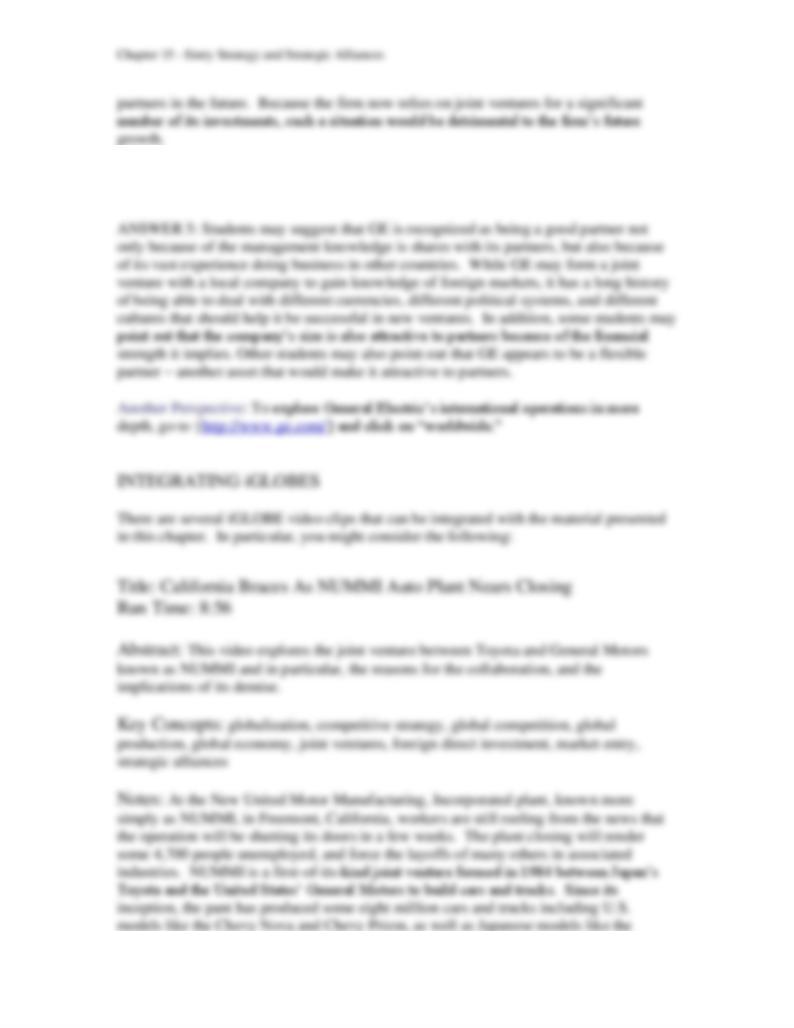
15-11
QUESTION 5: In addition to its reputation for being a good partner, what other assets do
you think GE brings to the table that make it an attractive joint venture partner?

Chapter 15 - Entry Strategy and Strategic Alliances
15-12
Toyota Corolla and Toyota Tacoma. Moreover, despite the announcement of its
impending closing, the plant is still running at full capacity today, producing new
Corollas and Tacomas at the rate of one every 54 seconds.
The decision to form NUMMI came about 25 years ago when Japanese automakers
wanted to expand into the U.S. market, and U.S. automakers wanted to learn new
production techniques. Toyota believed that its agreement with General Motors could
help it achieve several goals. The company wanted to learn how to do business in the
United States, how to manage unions, and how to deal with U.S. workers. General
Motors believed that collaboration with Toyota could help the company learn the more
efficient Japanese production techniques and implement a just-in-time delivery system.
According to Robert Cole of the University of California at Berkeley, Toyota more or
2. Reflect on the success of NUMMI. Did both partners benefit equally from the joint
venture? Why or why not?

Chapter 15 - Entry Strategy and Strategic Alliances
15-13
INTEGRATING VIDEOS
There are also several longer video clips that can be integrated with the material
presented in this chapter. In particular, you might consider the following from
International Business DVD Volume 6:
Title: UK Company Expands to Ukraine for Farming
Learning Objectives
The purpose of this video is to help you:
❖ Explore the ethics involved in foreign ownership of a country’s fundamental assets
like farmland.
❖ Discuss whether investments in land are a form of neocolonialism.
❖ Define foreign direct investment and identify factors that make a country attractive to
foreign investors.
❖ Consider the impact of foreign companies on the host country.
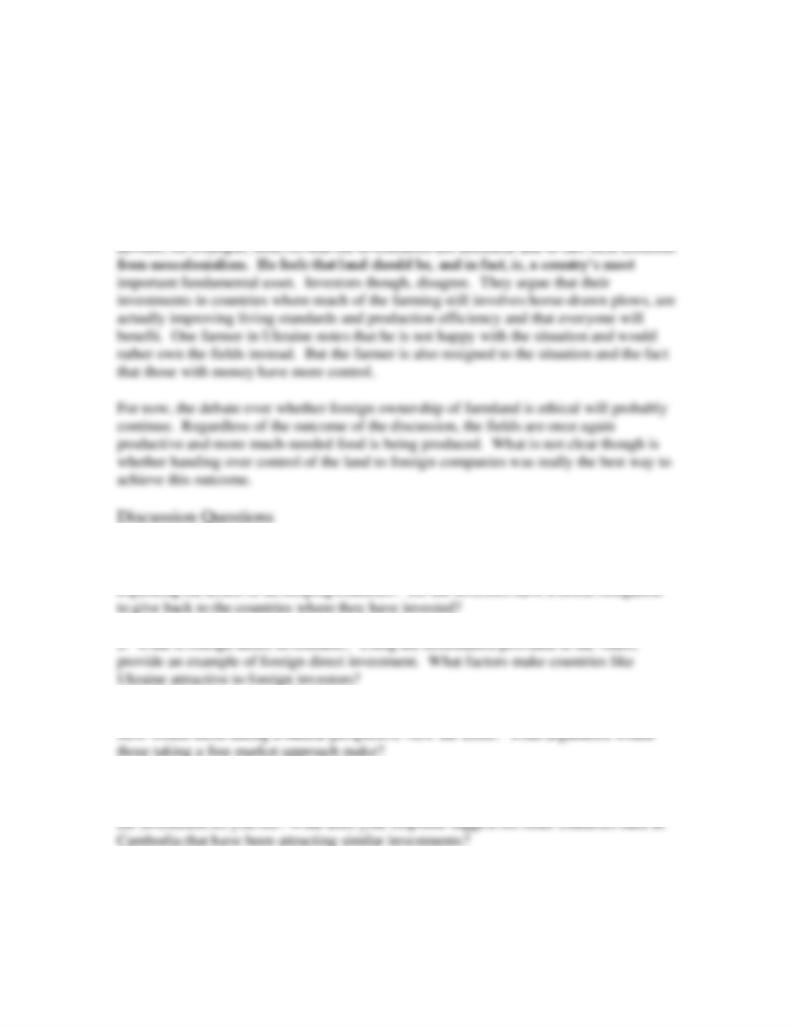
Chapter 15 - Entry Strategy and Strategic Alliances
15-14
country. Sprinks hopes to buy thousands of acres of unused farmland and convert them
to productive fields.
The investment by Landkom is part of a growing trend in the world. Countries and
companies, in response to dire predictions of global food shortages, are investing in land
with the hopes of growing crops. Britain has invested in Ukraine, China is buying up
land in Cambodia, and the Arab countries are investing in Africa. However, some are
questioning whether the investments are actually ethical. The British Food Security
1. Discuss the issues involved when countries and companies buy farmland in other
countries. Is the practice ethical? Why or why not? Are investors from rich countries
3. Consider the trend of investing in foreign farm land using different political ideologies.
4. Reflect on the costs and benefits of foreign direct investment. How is Ukraine
benefiting from investments like the one shown in the video? What adverse effects from
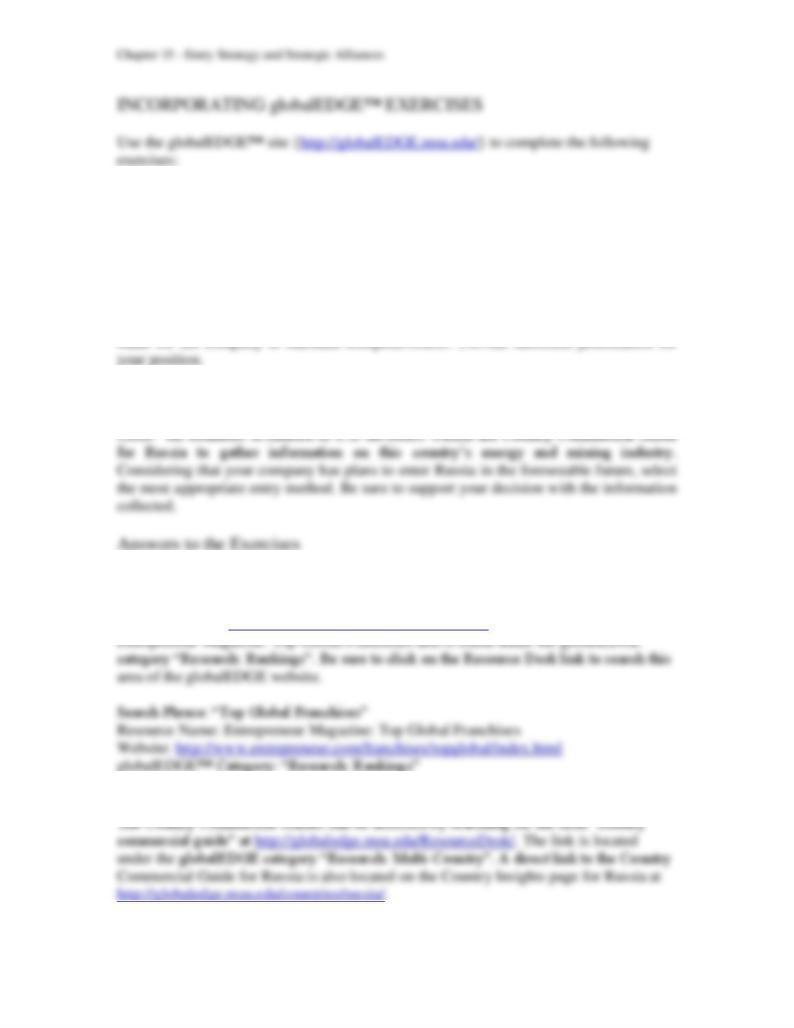
15-15
Exercise 1
A vital element in a successful international market entry strategy is an appropriate fit of
skills and capabilities between partners. As such, the Entrepreneur magazine annually
publishes a ranking of the “Top Global Franchises”. Provide a list of the top 10
companies that pursue franchising as a mode of international expansion. Study one of
these companies in detail and provide a description of its business model, its international
expansion pattern, desirable qualifications in possible franchisees, and the support and
training typically provided by the franchisor. Are there areas where improvement can be
Exercise 2
The U.S. Commercial Service prepares reports known as the “Country Commercial
Exercise 1
The annual ranking of the top 200 global franchisers can be found by searching the term
“entrepreneur” at http://globaledge.msu.edu/ResourceDesk/. This resource is named
Exercise 2

Chapter 15 - Entry Strategy and Strategic Alliances
15-16
Search Phrase: “Country Commercial Guide”
Resource Name: Country Commercial Guides for U.S. Investors
End of Part Case Notes
Part Five:
Coca-Cola
1. Why do you think that Roberto Goizueta switched from a strategy that emphasized
localization towards one that emphasized global standardization? What were the benefits
of such a strategy?
2. What were the limitations of Goizueta’s strategy that persuaded his successor, Daft, to
shift away from it? What was Daft trying to achieve? Datf’s strategy also did not
produce the desired results. Why do you think this was the case?
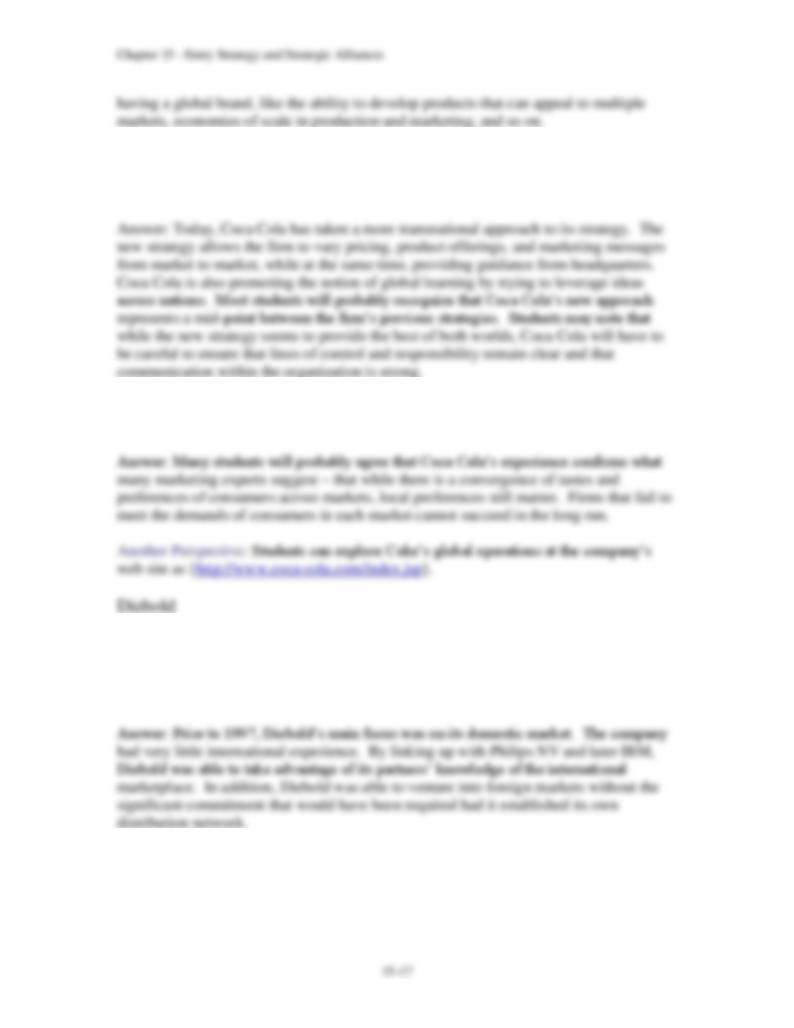
3. How would you characterize the strategy now being pursued by Coke? What is the
enterprise trying to do? How is this different from the strategies of both Goizueta and
Daft? What are the benefits? What are the potential costs and risks?
4. What does the evolution of Coke’s strategy tell you about the convergence of
consumer tastes and preferences in today’s global economy?
1. Prior to 1997, Diebold manufactured its ATM machines in the United States and sold
them internationally via distribution agreements, first with Philips NV and then with
IBM. Why do you think Diebold chose this mode of expanding internationally? What
were the advantages and disadvantages of this arrangement?

Chapter 15 - Entry Strategy and Strategic Alliances
2. What do you think prompted Diebold to alter its international expansion strategy in
1997 and start setting up wholly owned subsidiaries in most markets? Why do you think
the company favored acquisition as an entry mode?
3. Diebold entered China via a joint venture, as opposed to a wholly owned subsidiary.
Why do you think it did this?
4. Is Diebold pursuing a global standardization strategy or a localization strategy? Do
you think this choice of strategy has impacted upon its choice of entry mode? How?
1. What was the strategic rationale underlying JCB’s entry into India in 1979, and China
in 2005? Given that capital to fund expansion is limited, does it make more sense for
JCB to expand its presence in these markets, as opposed to more developed markets, such
as those of Western Europe?

Chapter 15 - Entry Strategy and Strategic Alliances
2. Why do you think JCB chose to enter India via a joint venture, as opposed to some
other entry mode?
3. Why did JCB not simply license its technology to Escorts?
4. What were the potential disadvantages of JCB’s joint venture with Escorts?
5. What were the benefits of gaining full control of the Indian joint venture in 2002? Can
you think of any drawbacks?
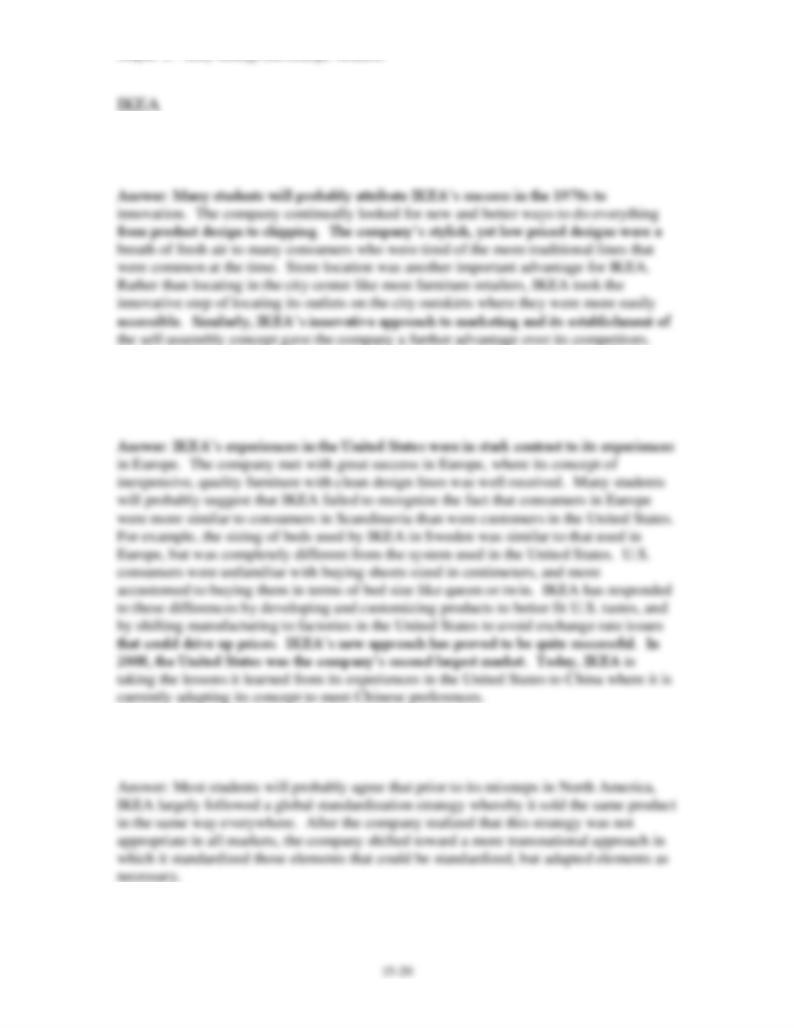
Chapter 15 - Entry Strategy and Strategic Alliances
1. By the early 1970s IKEA had established itself as the largest furniture retailer in
Sweden. What was the source of its competitive advantage at that time?
2. Why do you think IKEA’s expansion into Europe went so well? Why did the company
subsequently stumble in North America? What lessons did IKEA learn from this
experience? How is the company now applying these lessons?
3. How would you characterize IKEA’s strategy prior to its missteps in North America?
How would you characterize its strategy today?

Chapter 15 - Entry Strategy and Strategic Alliances
4. What is IKEA’s strategy towards its suppliers? How important is this strategy to
IKEA’s success?
5. What is the source of IKEA’s success today? Can you see any weaknesses in the
company? What might it do to correct these?